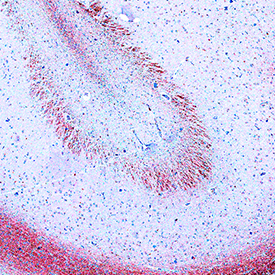Human Apolipoprotein E3/ApoE3 Antibody Summary
Accession # P02649
Applications
Please Note: Optimal dilutions should be determined by each laboratory for each application. General Protocols are available in the Technical Information section on our website.
Scientific Data
 View Larger
View Larger
Apolipoprotein E3/ApoE3 in Human Brain. Apolipoprotein E3/ApoE3 was detected in immersion fixed paraffin-embedded sections of human brain (hippocampus) using Mouse Anti-Human Apolipoprotein E3/ApoE3 Monoclonal Antibody (Catalog # MAB41443) at 5 µg/mL for 1 hour at room temperature followed by incubation with the Anti-Mouse IgG VisUCyte™ HRP Polymer Antibody (Catalog # VC001). Tissue was stained using DAB (brown) and counterstained with hematoxylin (blue). Specific staining was localized to cytoplasm. View our protocol for IHC Staining with VisUCyte HRP Polymer Detection Reagents.
Reconstitution Calculator
Preparation and Storage
- 12 months from date of receipt, -20 to -70 °C as supplied.
- 1 month, 2 to 8 °C under sterile conditions after reconstitution.
- 6 months, -20 to -70 °C under sterile conditions after reconstitution.
Background: Apolipoprotein E3/ApoE3
ApoE is a major protein component of serum LDL, VLDL, HDL, and chylomicrons. It is produced predominantly by hepatocytes, macrophages, and non-neuronal cells in the CNS. ApoE-containing particles transport triglycerides and cholesterol to peripheral tissues for cellular uptake and catabolism (1‑4). Mature human ApoE is a 37 kDa glycoprotein that consists of an N-terminal domain composed of four bundled alpha -helices, plus a hinge region and an extended alpha -helical C-terminal domain (2, 5). Its amphipathic nature and flexible structure enables it to adopt dramatically different conformations upon lipid association (2). ApoE is monomeric in lipid particles, although it forms oligomers when lipid-free (6). ApoE3 is the most abundant of the three common alleles in human; ApoE2 and ApoE4 differ by single aa substitutions (1). Mature human ApoE shares 71% aa sequence identity with mouse and rat ApoE. LDL receptor family proteins preferentially bind and internalize the lipid-bound form of ApoE with the exception of VLDLR which also efficiently internalizes lipid-free ApoE (7, 8). Lipoprotein uptake is facilitated by the initial binding of ApoE to cell surface heparan sulfate proteoglycans (HSPG) (9). Receptor/HSPG binding and lipid interactions primarily involve the N- and C-terminal regions of ApoE, respectively (2). Recycled lipid-free ApoE is formed into HDL particles through interactions with the lipid transporter ABCA1 (10). High cellular sterol content activates the nuclear hormone receptor LXR which promotes increased ApoE synthesis and increased sterol efflux, while low sterol content induces LDL R expression with increased sterol uptake and decreased ApoE production (11). ApoE3 dampens the TNF-alpha induced inflammatory response in vascular endothelial cells (12). In the CNS, ApoE blocks production of the amyloid A beta peptide by inhibiting the gamma -secretase cleavage of APP (13). It also complexes with A beta and promotes A beta internalization via LRP2 (14, 15).
- Martins, I.J. et al. (2006) Mol. Pschiatry 11:721.
- Hatters, D.M. et al. (2006) Trends Biochem. Sci. 31:445.
- Heeren, J. et al. (2006) Arterioscler. Thromb. Vasc. Biol. 26:442.
- Mahley, R.W. et al. (1984) J. Lipid. Res. 25:1277.
- Zannis, V.I. et al. (1984) J. Biol. Chem. 259:5495.
- Perugini, M.A. et al. (2000) J. Biol. Chem. 275:36758.
- Ruiz, J. et al. (2005) J. Lipid Res. 46:1721.
- Chroni, A. et al. (2005) Biochemistry 44:13132.
- Futamura, M. et al. (2005) J. Biol. Chem. 280:5414.
- Krimbou, L. et al. (2004) J. Lipid. Res. 45:839.
- Lucic, D. et al. (2007) J. Lipid Res. 48:366.
- Mullick, A.E. et al. (2007) Arterioscler. Thromb. Vasc. Biol. 27:339.
- Irizarry, M.C. et al. (2004) J. Neurochem. 90:1132.
- Naslund, J. et al. (1995) Neuron 15:219.
- Zerbinatti, C.V. et al. (2006) J. Biol. Chem. 281:36180.
Product Datasheets
FAQs
No product specific FAQs exist for this product, however you may
View all Antibody FAQsReviews for Human Apolipoprotein E3/ApoE3 Antibody
There are currently no reviews for this product. Be the first to review Human Apolipoprotein E3/ApoE3 Antibody and earn rewards!
Have you used Human Apolipoprotein E3/ApoE3 Antibody?
Submit a review and receive an Amazon gift card.
$25/€18/£15/$25CAN/¥75 Yuan/¥1250 Yen for a review with an image
$10/€7/£6/$10 CAD/¥70 Yuan/¥1110 Yen for a review without an image


